Variations in growth performance and nitrogen uptake of sugarcane cultivars under rain-fed conditions
The experiment was conducted to evaluate growth and nitrogen uptake of the twelve sugarcane varieties, viz. NiF3, NiF8, Ni9, Ni12, Ni15, Ni17, Ni21, Ni22, Ni25, Ni27, Ni28, and Ni29, under rain-Fed conditions during the period from 70 to 160 days after transplanting (DAT) at the experimental field, Faculty of Agriculture, University of the Ryukyus, Okinawa, Japan. The results showed that water shortage from a rain-fed condition caused reductions, but not significant in plant height and SPAD of sugarcane varieties. The genetic variation in leaf area, yield components, partial and total biomass, and cane yield was found among the investigated varieties. The positive associations between total nitrogen uptake with total biomass production and cane yield suggested that higher nitrogen uptake supports better growth performance of sugarcane under rainfed conditions. From this study, NiF3 and Ni27 could be introduced as the promising sugarcane varieties for better growth performance and high nitrogen uptake under rain-fed conditions
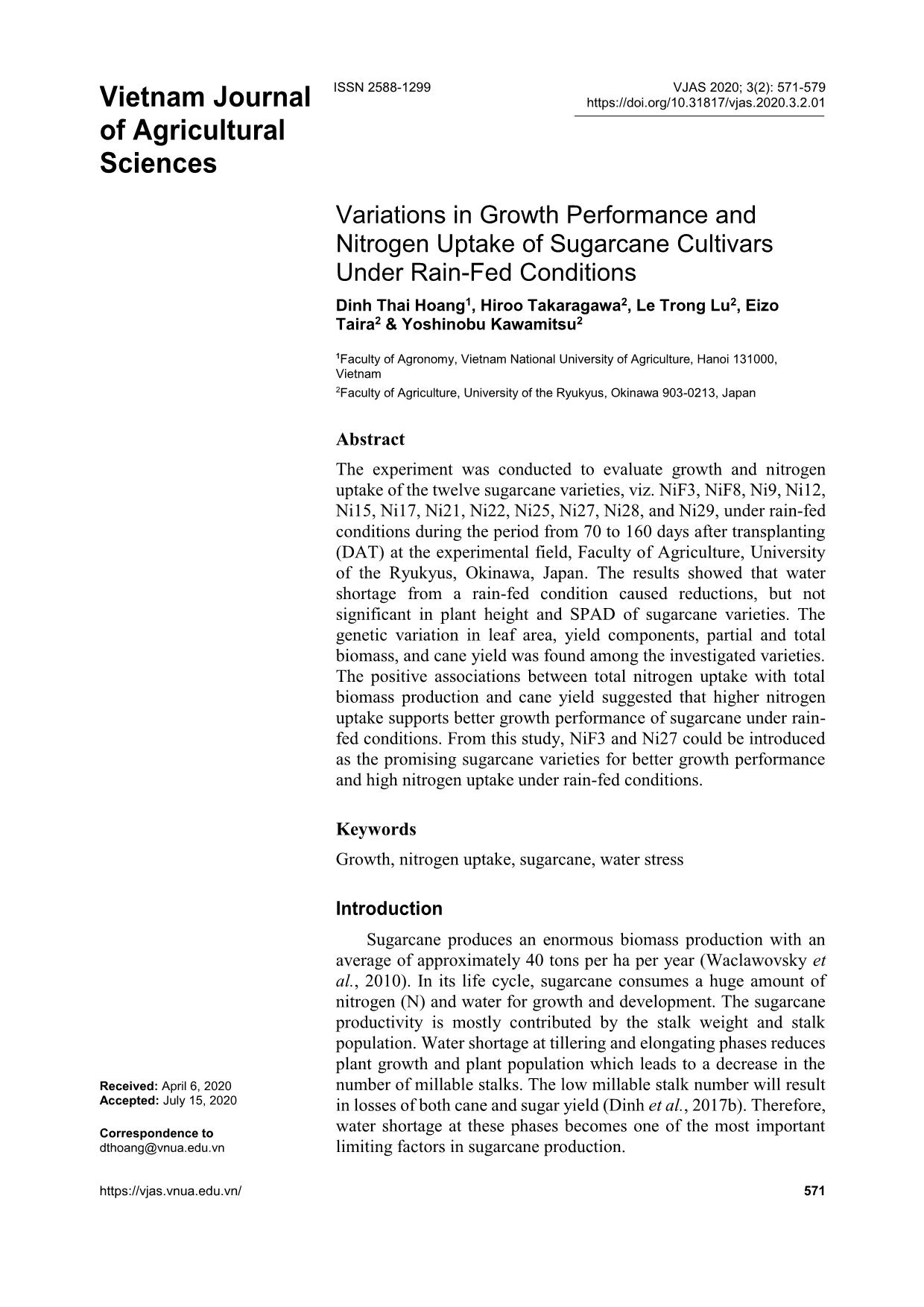
Trang 1
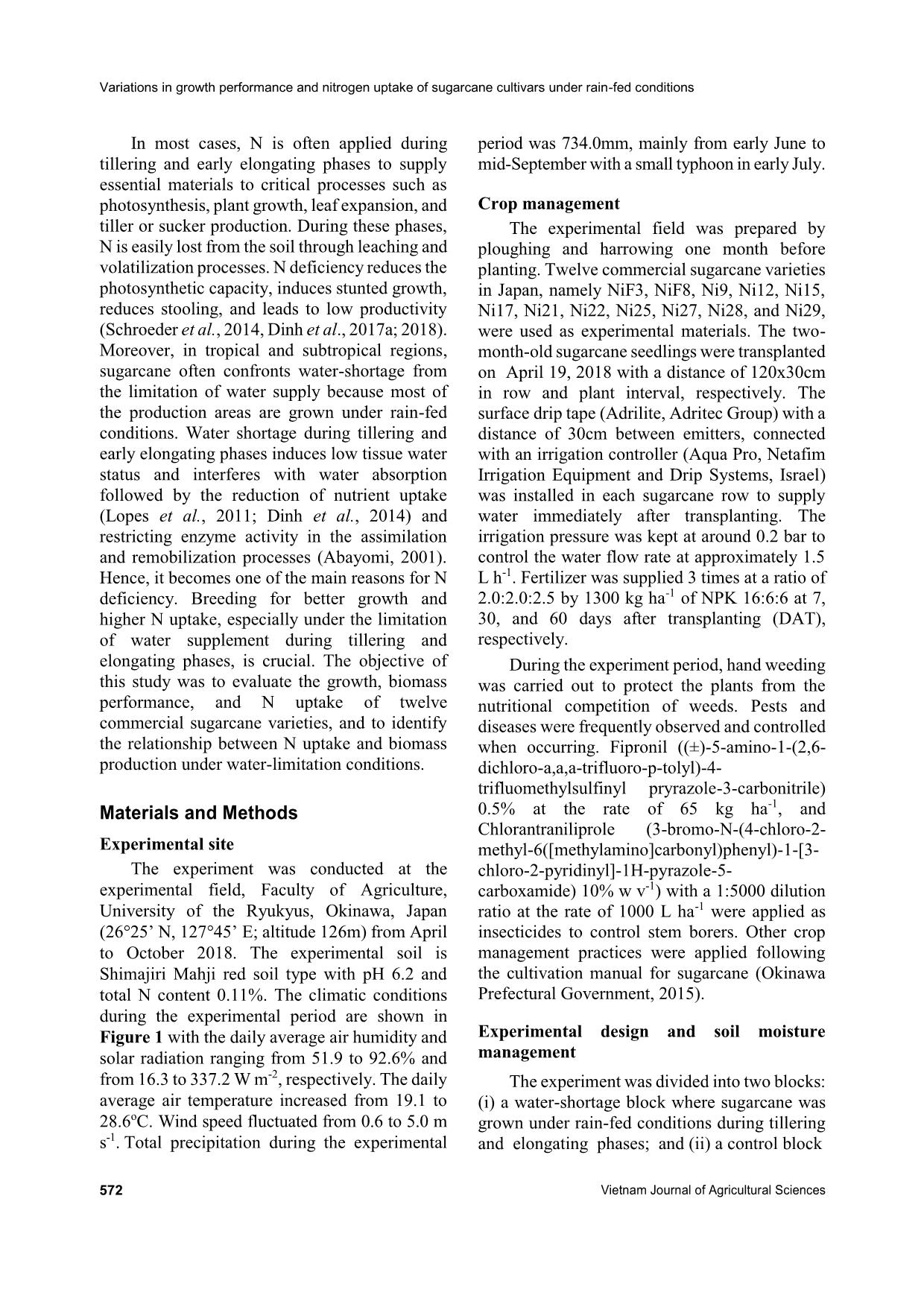
Trang 2
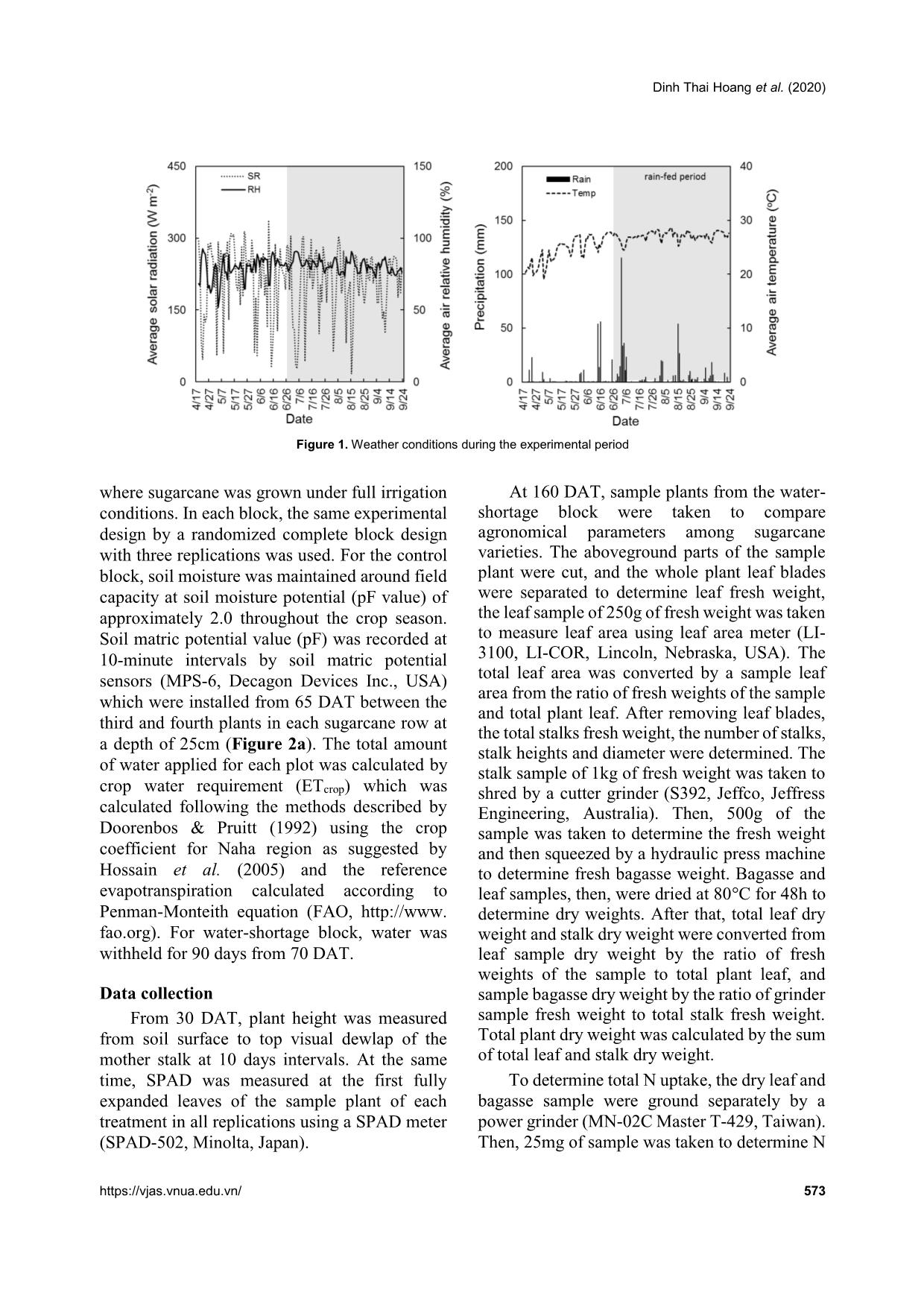
Trang 3
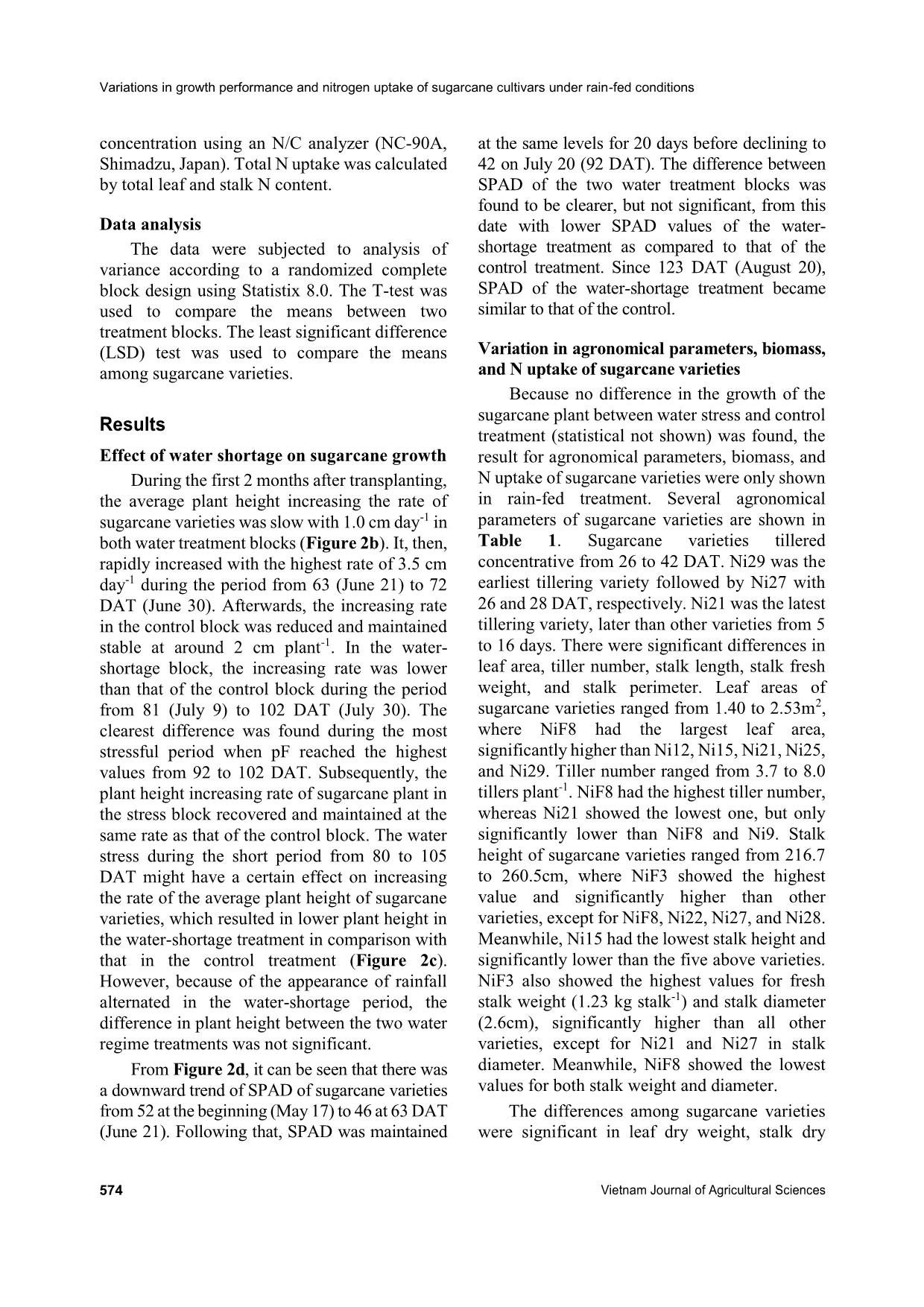
Trang 4

Trang 5
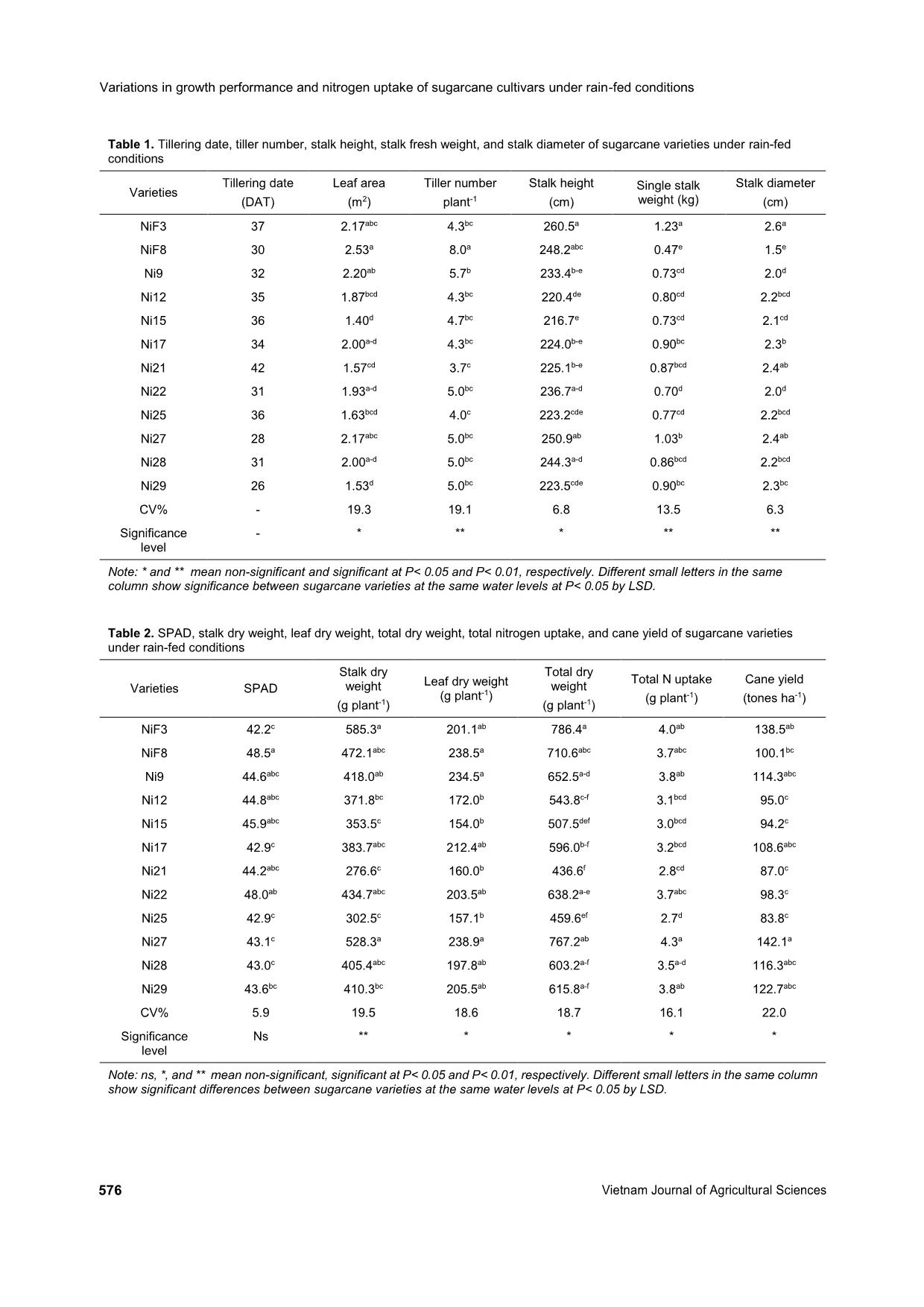
Trang 6
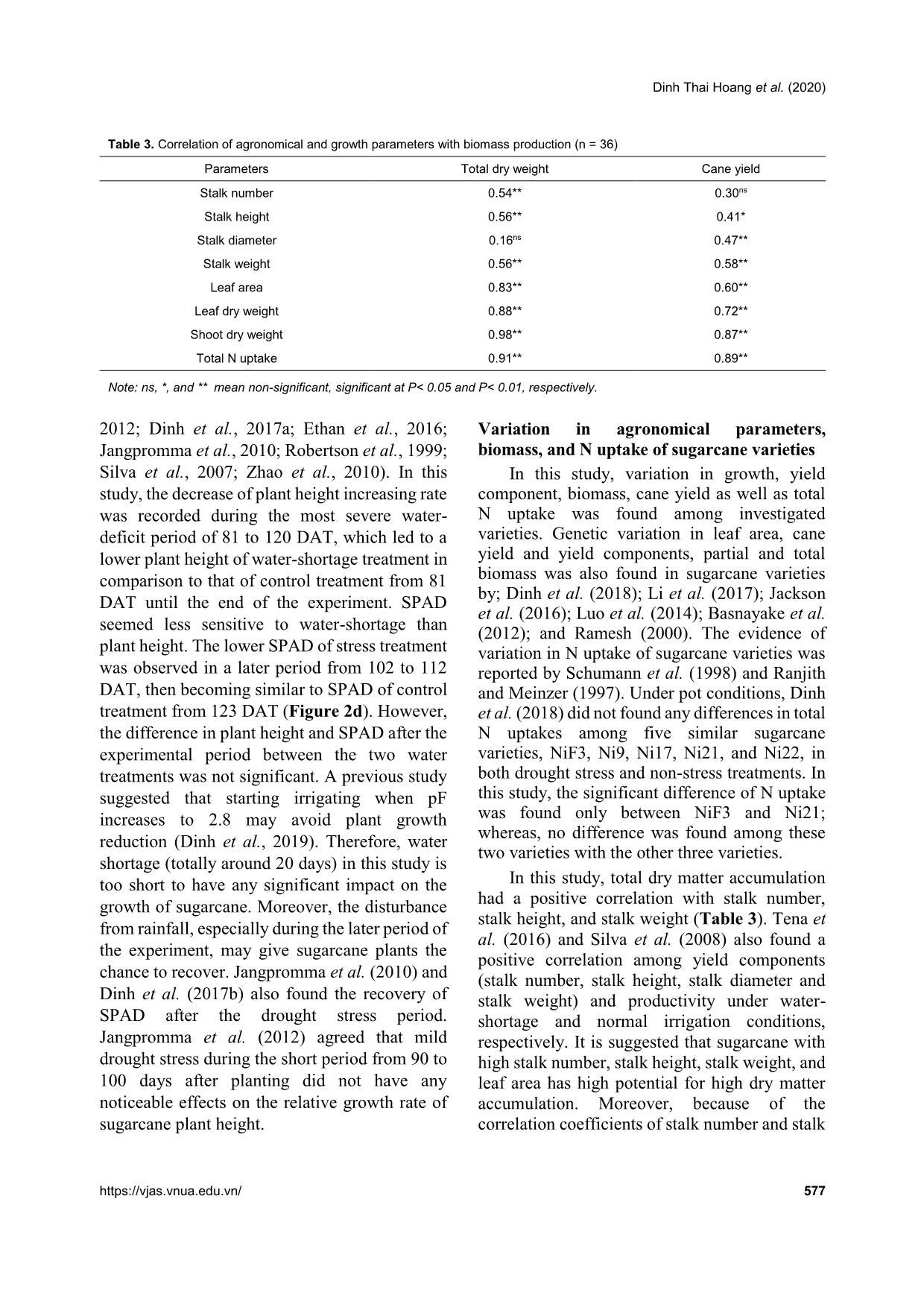
Trang 7
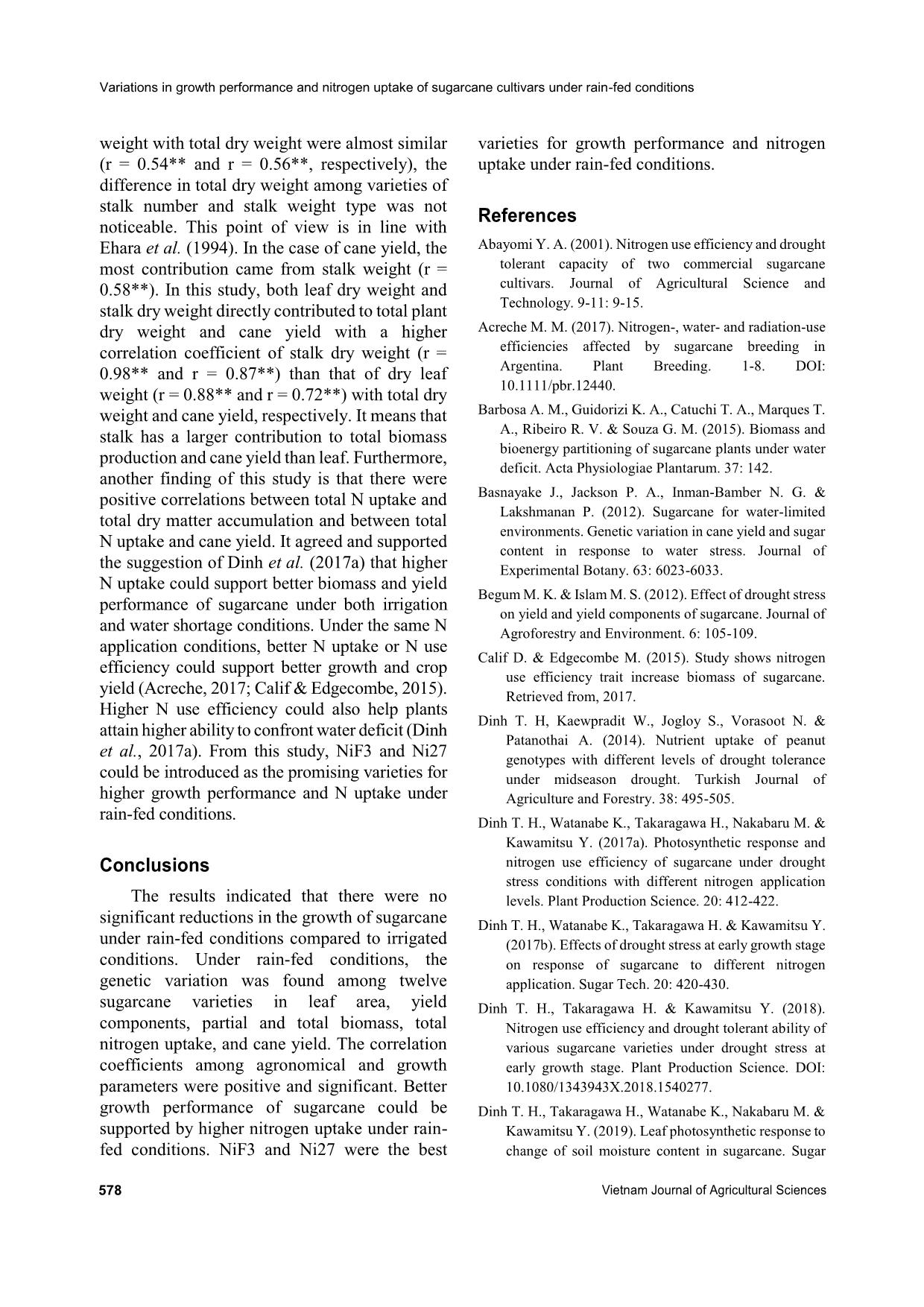
Trang 8
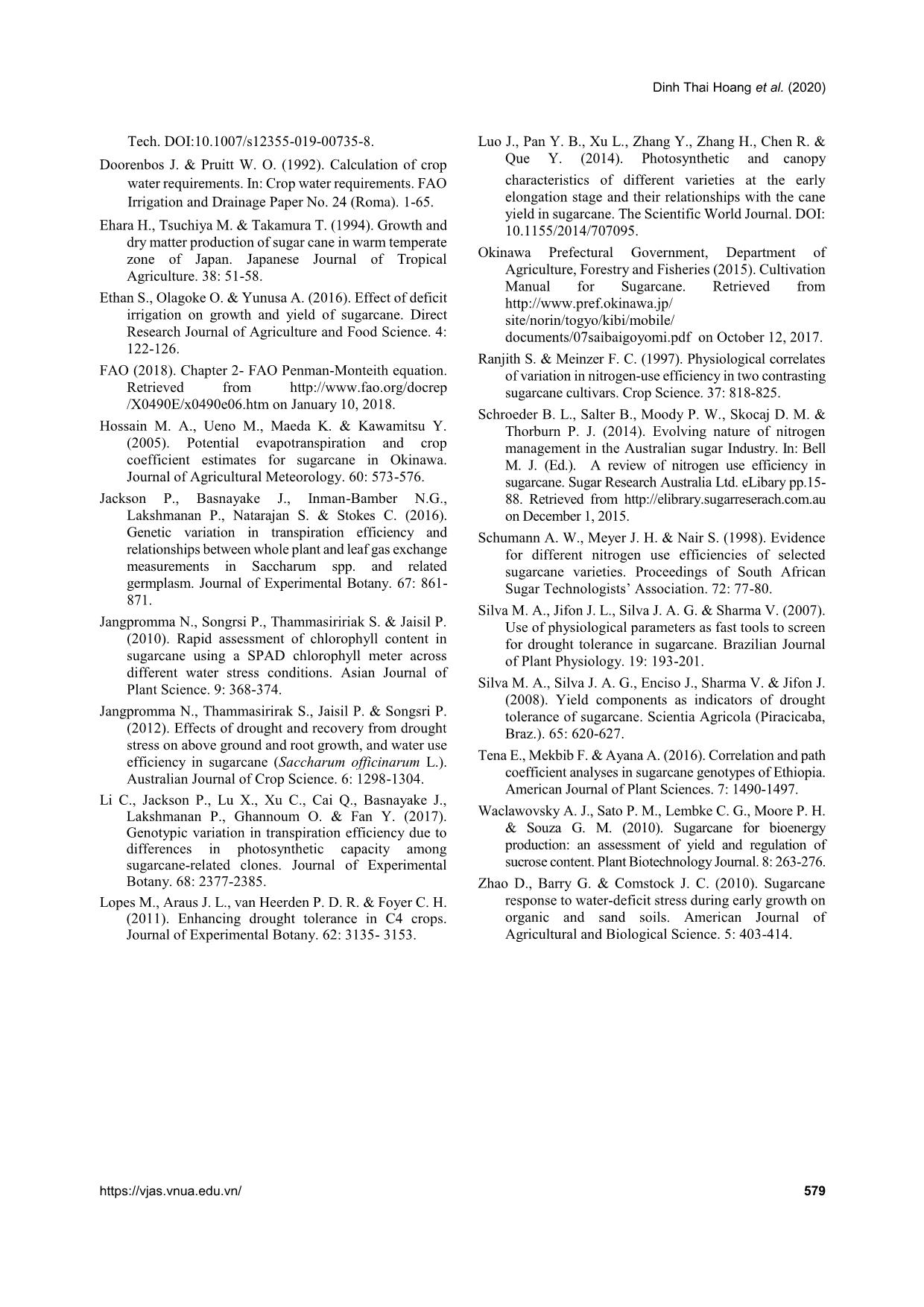
Trang 9
Tóm tắt nội dung tài liệu: Variations in growth performance and nitrogen uptake of sugarcane cultivars under rain-fed conditions
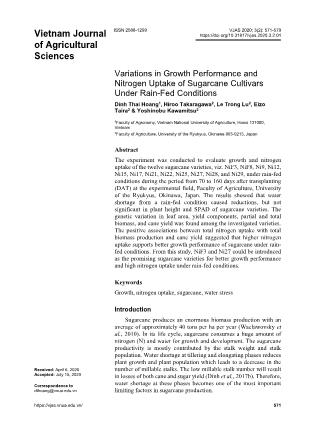
35 1.87bcd 4.3bc 220.4de 0.80cd 2.2bcd Ni15 36 1.40d 4.7bc 216.7e 0.73cd 2.1cd Ni17 34 2.00a-d 4.3bc 224.0b-e 0.90bc 2.3b Ni21 42 1.57cd 3.7c 225.1b-e 0.87bcd 2.4ab Ni22 31 1.93a-d 5.0bc 236.7a-d 0.70d 2.0d Ni25 36 1.63bcd 4.0c 223.2cde 0.77cd 2.2bcd Ni27 28 2.17abc 5.0bc 250.9ab 1.03b 2.4ab Ni28 31 2.00a-d 5.0bc 244.3a-d 0.86bcd 2.2bcd Ni29 26 1.53d 5.0bc 223.5cde 0.90bc 2.3bc CV% - 19.3 19.1 6.8 13.5 6.3 Significance level - * ** * ** ** Note: * and ** mean non-significant and significant at P< 0.05 and P< 0.01, respectively. Different small letters in the same column show significance between sugarcane varieties at the same water levels at P< 0.05 by LSD. Table 2. SPAD, stalk dry weight, leaf dry weight, total dry weight, total nitrogen uptake, and cane yield of sugarcane varieties under rain-fed conditions Varieties SPAD Stalk dry weight (g plant-1) Leaf dry weight (g plant-1) Total dry weight (g plant-1) Total N uptake (g plant-1) Cane yield (tones ha-1) NiF3 42.2c 585.3a 201.1ab 786.4a 4.0ab 138.5ab NiF8 48.5a 472.1abc 238.5a 710.6abc 3.7abc 100.1bc Ni9 44.6abc 418.0ab 234.5a 652.5a-d 3.8ab 114.3abc Ni12 44.8abc 371.8bc 172.0b 543.8c-f 3.1bcd 95.0c Ni15 45.9abc 353.5c 154.0b 507.5def 3.0bcd 94.2c Ni17 42.9c 383.7abc 212.4ab 596.0b-f 3.2bcd 108.6abc Ni21 44.2abc 276.6c 160.0b 436.6f 2.8cd 87.0c Ni22 48.0ab 434.7abc 203.5ab 638.2a-e 3.7abc 98.3c Ni25 42.9c 302.5c 157.1b 459.6ef 2.7d 83.8c Ni27 43.1c 528.3a 238.9a 767.2ab 4.3a 142.1a Ni28 43.0c 405.4abc 197.8ab 603.2a-f 3.5a-d 116.3abc Ni29 43.6bc 410.3bc 205.5ab 615.8a-f 3.8ab 122.7abc CV% 5.9 19.5 18.6 18.7 16.1 22.0 Significance level Ns ** * * * * Note: ns, *, and ** mean non-significant, significant at P< 0.05 and P< 0.01, respectively. Different small letters in the same column show significant differences between sugarcane varieties at the same water levels at P< 0.05 by LSD. Dinh Thai Hoang et al. (2020) https://vjas.vnua.edu.vn/ 577 Table 3. Correlation of agronomical and growth parameters with biomass production (n = 36) Parameters Total dry weight Cane yield Stalk number 0.54** 0.30ns Stalk height 0.56** 0.41* Stalk diameter 0.16ns 0.47** Stalk weight 0.56** 0.58** Leaf area 0.83** 0.60** Leaf dry weight 0.88** 0.72** Shoot dry weight 0.98** 0.87** Total N uptake 0.91** 0.89** Note: ns, *, and ** mean non-significant, significant at P< 0.05 and P< 0.01, respectively. 2012; Dinh et al., 2017a; Ethan et al., 2016; Jangpromma et al., 2010; Robertson et al., 1999; Silva et al., 2007; Zhao et al., 2010). In this study, the decrease of plant height increasing rate was recorded during the most severe water- deficit period of 81 to 120 DAT, which led to a lower plant height of water-shortage treatment in comparison to that of control treatment from 81 DAT until the end of the experiment. SPAD seemed less sensitive to water-shortage than plant height. The lower SPAD of stress treatment was observed in a later period from 102 to 112 DAT, then becoming similar to SPAD of control treatment from 123 DAT (Figure 2d). However, the difference in plant height and SPAD after the experimental period between the two water treatments was not significant. A previous study suggested that starting irrigating when pF increases to 2.8 may avoid plant growth reduction (Dinh et al., 2019). Therefore, water shortage (totally around 20 days) in this study is too short to have any significant impact on the growth of sugarcane. Moreover, the disturbance from rainfall, especially during the later period of the experiment, may give sugarcane plants the chance to recover. Jangpromma et al. (2010) and Dinh et al. (2017b) also found the recovery of SPAD after the drought stress period. Jangpromma et al. (2012) agreed that mild drought stress during the short period from 90 to 100 days after planting did not have any noticeable effects on the relative growth rate of sugarcane plant height. Variation in agronomical parameters, biomass, and N uptake of sugarcane varieties In this study, variation in growth, yield component, biomass, cane yield as well as total N uptake was found among investigated varieties. Genetic variation in leaf area, cane yield and yield components, partial and total biomass was also found in sugarcane varieties by; Dinh et al. (2018); Li et al. (2017); Jackson et al. (2016); Luo et al. (2014); Basnayake et al. (2012); and Ramesh (2000). The evidence of variation in N uptake of sugarcane varieties was reported by Schumann et al. (1998) and Ranjith and Meinzer (1997). Under pot conditions, Dinh et al. (2018) did not found any differences in total N uptakes among five similar sugarcane varieties, NiF3, Ni9, Ni17, Ni21, and Ni22, in both drought stress and non-stress treatments. In this study, the significant difference of N uptake was found only between NiF3 and Ni21; whereas, no difference was found among these two varieties with the other three varieties. In this study, total dry matter accumulation had a positive correlation with stalk number, stalk height, and stalk weight (Table 3). Tena et al. (2016) and Silva et al. (2008) also found a positive correlation among yield components (stalk number, stalk height, stalk diameter and stalk weight) and productivity under water- shortage and normal irrigation conditions, respectively. It is suggested that sugarcane with high stalk number, stalk height, stalk weight, and leaf area has high potential for high dry matter accumulation. Moreover, because of the correlation coefficients of stalk number and stalk Variations in growth performance and nitrogen uptake of sugarcane cultivars under rain-fed conditions 578 Vietnam Journal of Agricultural Sciences weight with total dry weight were almost similar (r = 0.54** and r = 0.56**, respectively), the difference in total dry weight among varieties of stalk number and stalk weight type was not noticeable. This point of view is in line with Ehara et al. (1994). In the case of cane yield, the most contribution came from stalk weight (r = 0.58**). In this study, both leaf dry weight and stalk dry weight directly contributed to total plant dry weight and cane yield with a higher correlation coefficient of stalk dry weight (r = 0.98** and r = 0.87**) than that of dry leaf weight (r = 0.88** and r = 0.72**) with total dry weight and cane yield, respectively. It means that stalk has a larger contribution to total biomass production and cane yield than leaf. Furthermore, another finding of this study is that there were positive correlations between total N uptake and total dry matter accumulation and between total N uptake and cane yield. It agreed and supported the suggestion of Dinh et al. (2017a) that higher N uptake could support better biomass and yield performance of sugarcane under both irrigation and water shortage conditions. Under the same N application conditions, better N uptake or N use efficiency could support better growth and crop yield (Acreche, 2017; Calif & Edgecombe, 2015). Higher N use efficiency could also help plants attain higher ability to confront water deficit (Dinh et al., 2017a). From this study, NiF3 and Ni27 could be introduced as the promising varieties for higher growth performance and N uptake under rain-fed conditions. Conclusions The results indicated that there were no significant reductions in the growth of sugarcane under rain-fed conditions compared to irrigated conditions. Under rain-fed conditions, the genetic variation was found among twelve sugarcane varieties in leaf area, yield components, partial and total biomass, total nitrogen uptake, and cane yield. The correlation coefficients among agronomical and growth parameters were positive and significant. Better growth performance of sugarcane could be supported by higher nitrogen uptake under rain- fed conditions. NiF3 and Ni27 were the best varieties for growth performance and nitrogen uptake under rain-fed conditions. References Abayomi Y. A. (2001). Nitrogen use efficiency and drought tolerant capacity of two commercial sugarcane cultivars. Journal of Agricultural Science and Technology. 9-11: 9-15. Acreche M. M. (2017). Nitrogen-, water- and radiation-use efficiencies affected by sugarcane breeding in Argentina. Plant Breeding. 1-8. DOI: 10.1111/pbr.12440. Barbosa A. M., Guidorizi K. A., Catuchi T. A., Marques T. A., Ribeiro R. V. & Souza G. M. (2015). Biomass and bioenergy partitioning of sugarcane plants under water deficit. Acta Physiologiae Plantarum. 37: 142. Basnayake J., Jackson P. A., Inman-Bamber N. G. & Lakshmanan P. (2012). Sugarcane for water-limited environments. Genetic variation in cane yield and sugar content in response to water stress. Journal of Experimental Botany. 63: 6023-6033. Begum M. K. & Islam M. S. (2012). Effect of drought stress on yield and yield components of sugarcane. Journal of Agroforestry and Environment. 6: 105-109. Calif D. & Edgecombe M. (2015). Study shows nitrogen use efficiency trait increase biomass of sugarcane. Retrieved from, 2017. Dinh T. H, Kaewpradit W., Jogloy S., Vorasoot N. & Patanothai A. (2014). Nutrient uptake of peanut genotypes with different levels of drought tolerance under midseason drought. Turkish Journal of Agriculture and Forestry. 38: 495-505. Dinh T. H., Watanabe K., Takaragawa H., Nakabaru M. & Kawamitsu Y. (2017a). Photosynthetic response and nitrogen use efficiency of sugarcane under drought stress conditions with different nitrogen application levels. Plant Production Science. 20: 412-422. Dinh T. H., Watanabe K., Takaragawa H. & Kawamitsu Y. (2017b). Effects of drought stress at early growth stage on response of sugarcane to different nitrogen application. Sugar Tech. 20: 420-430. Dinh T. H., Takaragawa H. & Kawamitsu Y. (2018). Nitrogen use efficiency and drought tolerant ability of various sugarcane varieties under drought stress at early growth stage. Plant Production Science. DOI: 10.1080/1343943X.2018.1540277. Dinh T. H., Takaragawa H., Watanabe K., Nakabaru M. & Kawamitsu Y. (2019). Leaf photosynthetic response to change of soil moisture content in sugarcane. Sugar Dinh Thai Hoang et al. (2020) https://vjas.vnua.edu.vn/ 579 Tech. DOI:10.1007/s12355-019-00735-8. Doorenbos J. & Pruitt W. O. (1992). Calculation of crop water requirements. In: Crop water requirements. FAO Irrigation and Drainage Paper No. 24 (Roma). 1-65. Ehara H., Tsuchiya M. & Takamura T. (1994). Growth and dry matter production of sugar cane in warm temperate zone of Japan. Japanese Journal of Tropical Agriculture. 38: 51-58. Ethan S., Olagoke O. & Yunusa A. (2016). Effect of deficit irrigation on growth and yield of sugarcane. Direct Research Journal of Agriculture and Food Science. 4: 122-126. FAO (2018). Chapter 2- FAO Penman-Monteith equation. Retrieved from /X0490E/x0490e06.htm on January 10, 2018. Hossain M. A., Ueno M., Maeda K. & Kawamitsu Y. (2005). Potential evapotranspiration and crop coefficient estimates for sugarcane in Okinawa. Journal of Agricultural Meteorology. 60: 573-576. Jackson P., Basnayake J., Inman-Bamber N.G., Lakshmanan P., Natarajan S. & Stokes C. (2016). Genetic variation in transpiration efficiency and relationships between whole plant and leaf gas exchange measurements in Saccharum spp. and related germplasm. Journal of Experimental Botany. 67: 861- 871. Jangpromma N., Songrsi P., Thammasiririak S. & Jaisil P. (2010). Rapid assessment of chlorophyll content in sugarcane using a SPAD chlorophyll meter across different water stress conditions. Asian Journal of Plant Science. 9: 368-374. Jangpromma N., Thammasirirak S., Jaisil P. & Songsri P. (2012). Effects of drought and recovery from drought stress on above ground and root growth, and water use efficiency in sugarcane (Saccharum officinarum L.). Australian Journal of Crop Science. 6: 1298-1304. Li C., Jackson P., Lu X., Xu C., Cai Q., Basnayake J., Lakshmanan P., Ghannoum O. & Fan Y. (2017). Genotypic variation in transpiration efficiency due to differences in photosynthetic capacity among sugarcane-related clones. Journal of Experimental Botany. 68: 2377-2385. Lopes M., Araus J. L., van Heerden P. D. R. & Foyer C. H. (2011). Enhancing drought tolerance in C4 crops. Journal of Experimental Botany. 62: 3135- 3153. Luo J., Pan Y. B., Xu L., Zhang Y., Zhang H., Chen R. & Que Y. (2014). Photosynthetic and canopy characteristics of different varieties at the early elongation stage and their relationships with the cane yield in sugarcane. The Scientific World Journal. DOI: 10.1155/2014/707095. Okinawa Prefectural Government, Department of Agriculture, Forestry and Fisheries (2015). Cultivation Manual for Sugarcane. Retrieved from site/norin/togyo/kibi/mobile/ documents/07saibaigoyomi.pdf on October 12, 2017. Ranjith S. & Meinzer F. C. (1997). Physiological correlates of variation in nitrogen-use efficiency in two contrasting sugarcane cultivars. Crop Science. 37: 818-825. Schroeder B. L., Salter B., Moody P. W., Skocaj D. M. & Thorburn P. J. (2014). Evolving nature of nitrogen management in the Australian sugar Industry. In: Bell M. J. (Ed.). A review of nitrogen use efficiency in sugarcane. Sugar Research Australia Ltd. eLibary pp.15- 88. Retrieved from on December 1, 2015. Schumann A. W., Meyer J. H. & Nair S. (1998). Evidence for different nitrogen use efficiencies of selected sugarcane varieties. Proceedings of South African Sugar Technologists’ Association. 72: 77-80. Silva M. A., Jifon J. L., Silva J. A. G. & Sharma V. (2007). Use of physiological parameters as fast tools to screen for drought tolerance in sugarcane. Brazilian Journal of Plant Physiology. 19: 193-201. Silva M. A., Silva J. A. G., Enciso J., Sharma V. & Jifon J. (2008). Yield components as indicators of drought tolerance of sugarcane. Scientia Agricola (Piracicaba, Braz.). 65: 620-627. Tena E., Mekbib F. & Ayana A. (2016). Correlation and path coefficient analyses in sugarcane genotypes of Ethiopia. American Journal of Plant Sciences. 7: 1490-1497. Waclawovsky A. J., Sato P. M., Lembke C. G., Moore P. H. & Souza G. M. (2010). Sugarcane for bioenergy production: an assessment of yield and regulation of sucrose content. Plant Biotechnology Journal. 8: 263-276. Zhao D., Barry G. & Comstock J. C. (2010). Sugarcane response to water-deficit stress during early growth on organic and sand soils. American Journal of Agricultural and Biological Science. 5: 403-414.
File đính kèm:
 variations_in_growth_performance_and_nitrogen_uptake_of_suga.pdf
variations_in_growth_performance_and_nitrogen_uptake_of_suga.pdf

